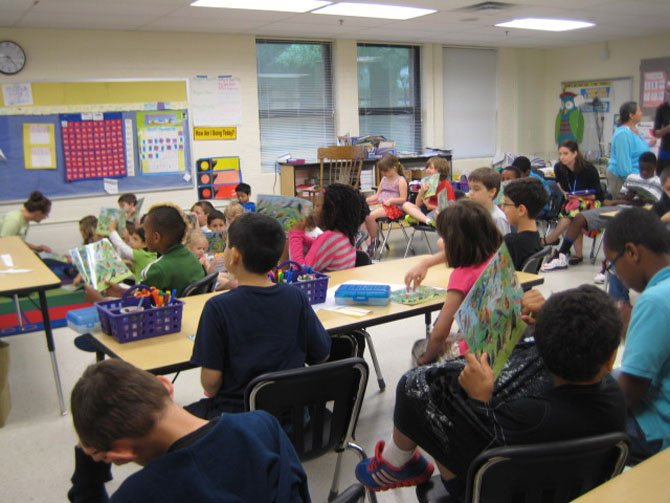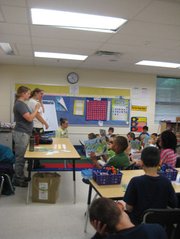Ms. Sherry’s second grade class studies their bird identification guides. Photo by Lauren Young/The Connection
Throughout the last two weeks, the Smithsonian Migratory Bird Center has sent ornithologists to Lake Anne Elementary School to teach all grade levels about birds. An ornithologist is a scientist that studies the health and habitat of birds. They capture birds and measure the legs for bone growth and the length of the feathers. These measurements, along with the weight, indicate the health of the bird. They also study the habitats of birds, which may be an indicator of the health of the birds in the area.
The ornithologists who visited Lake Anne also specialize in education, so they are able to teach all sorts of groups about their profession in an understandable manner. The way they described their profession to the students was calling themselves “bird doctors.” By capturing the birds in large nets, they are able to put a small metal band with a unique 9-digit combination, as well as two colored bands around the bird’s leg. The purpose of doing this is so that anyone who sees this specific banded bird can enter information about the sighting into an online database. Renee Timbers, a second grade student, enjoyed learning about the banding part of the presentation. At the end of the session she recalled, “That they band birds and measure their weight and how tall they are. The bands have different numbers on them.”
The three scientists, Jordan Rutter, Allie Mayes and Michelle Franco, started off the session by asking the children to describe where they usually see birds, and if they could name these birds. They received an enthusiastic response as most students were eager to describe their viewings of “backyard birds.” They had the students think even deeper when they asked them to describe the characteristics of birds, and unique features they have observed from their sightings. Jordan Rutter, an educator and ornithologist for the Smithsonian, said the purpose of the program is to, “help connect people, specifically kids, with the environment through birds.” They work with all kinds of schools, groups and clubs within a 50-mile radius of the Smithsonian Zoo to accomplish this purpose.
At the end of the program, the three leaders passed out identification guides of birds to the children for them to take home. The students are encouraged to keep it somewhere handy so they can use to identify birds they see. The diagrams help the students pick out unique characteristics such as color, shape, tail size and beak color in birds they see. The guides were a good teaching tool because Bryanna Melgar, a student of Lake Anne, said, “I learned some bird names, and I learned how they measure the birds. Also how birds have different colors.” Vania Zeledon, a second grader at Lake Anne, clearly remembered from the presentation, “That there are 10,000 different kinds of birds in this entire world.”
The students learned more than just biology from the ornithologists. As Jordan Rutter said, “They learn how to be more aware of their environment. They develop an appreciation for nature in their own backyard.”


